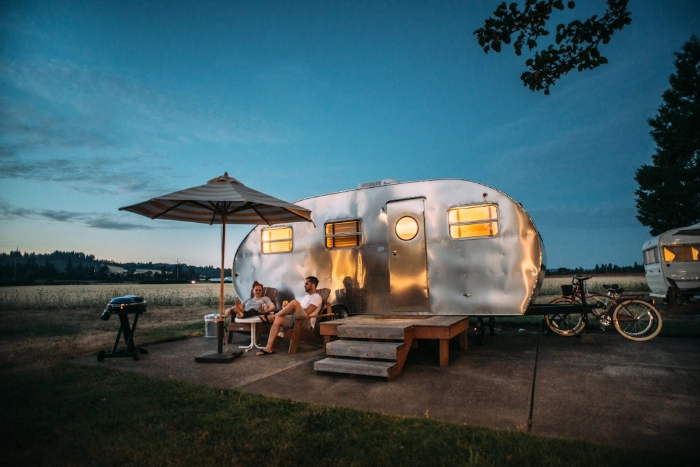How to Dewinterize Your RV the Right Way

Spring is here. Or... at least almost here.
And if you’re like many — staring at your RV and daydreaming about that first camping trip — it’s time to talk about how to dewinterize your RV properly. Trust me, this is not one of those skip-a-step-and-hope-for-the-best situations.
Skipping parts of this process can lead to expensive repairs or worse — drinking weird-tasting antifreeze leftovers in your morning coffee. Ask me how I know.
Here’s exactly what I do every year to wake my RVs back up after winter — in a way that’s easy to follow and beginner-friendly.
When Should You Dewinterize Your RV?
First things first — timing matters.
If you dewinterize too early and get hit with one surprise frost overnight? Cracked pipes. Frozen valves. Big repair bill.
Wait until the freezing temps are consistently gone. On Vancouver Island, where I spend most of my Spring, that’s usually around March or April — but it really depends on where you camp.
Not sure if it’s time yet? I share a full guide on how to winterize your RV too — because both ends of this seasonal dance matter.
Step 1: Flush Out That Antifreeze
Most RV owners use non-toxic pink antifreeze to protect their water systems over winter. But you definitely do not want that stuff sticking around.
Here’s how to flush it all out:
Drain the fresh water tank.
Hook up to city water with a regulator.
Open every faucet (hot & cold) until the water runs clear — sinks, showers, toilets, outdoor showers... all of it. keep checking on your black and grey tanks if they are closed, too much water will overflow them.
Don’t forget the water heater. Switch off the bypass and let it fill & flush clear.
Drain & rinse your holding tanks. (Both grey and black tanks — yes, even if you didn’t use them!)
Step 2: Sanitize Your RV Water System
Clean, safe drinking water is non-negotiable. You should sanitize even if you don't drink from it, washing dishes etc in unsafe water is a No-No.
The simplest way to sanitize your system:
Mix 1/4 cup regular bleach for every 15 gallons of your fresh water tank.
Fill your tank with potable water.
Run the mixture through all faucets until you smell bleach.
Let it sit 8-12 hours max.
Drain & flush until the bleach smell is gone.
Not a bleach fan? They do make RV-specific sanitizers, but bleach is cheap and easy if you rinse well. As a former restaurant manager with the food safe certificate, I can assure you bleach is used often in professional kitchens and if used properly will not harm you or your systems.
Step 3: Check Batteries, Power & Propane
Sitting all winter can be hard on your RV’s power systems.
Check:
House batteries — clean connections, check water levels (if applicable), and charge fully.
Test outlets & lights.
Flip on appliances. Cool your fridge before you hit the road, but turn it off if it's running on propane when you hit the road.
Inspect solar if you use it (here’s my setup with this portable solar generator).
Refill propane and check for leaks with soapy water.
Need a portable power boost while you camp? I compared the Anker Solix F1200 and BLUETTI AC70 — both killer options for van life or boondocking.
Step 4: Inspect Tires, Brakes & Safety Gear
Even if your RV didn’t move all winter, tires lose pressure and can develop flat spots.
Check:
Tire pressure & tread
Look for cracks or bulges
Test brakes (if it’s a motorhome or towed trailer)
Check propane & carbon monoxide alarms
Inspect fire extinguishers
Replace water filters if you use them
Planning a road trip soon? Don't miss my guide on how to tow a car behind an RV.
Step 5: Clean It Like You Mean It
This is your chance to shake off that winter funk.
Outside:
Gentle hand wash (avoid pressure washers on seals)
Check seals & caulking
Inspect roof & windows
Wax or protect exterior if needed
Inside:
Vacuum & wipe everything down
Open windows to air it out
Replace linens, restock supplies
Look for signs of mice — or better yet, learn how to repel rodents from your RV
RV Dewinterizing Shopping List
Handy gear I keep on hand every spring:
Drinking water hose
Water pressure regulator
RV-safe sanitizer or bleach
Disposable gloves
Tire pressure gauge
Freshwater filter
Lubricant spray (for seals & hinges)
Batteries for alarms
Propane refill
Final Thoughts: Enjoy That First Trip!
Dewinterizing your RV is one of those seasonal chores that feels like a pain... until you skip it and regret it later.
But once it’s done? The fun starts. Fresh air. Campfires. Bugs. (Get ready with my guide to mosquito repellent for camping. You’ll thank me later.)
Now go hit the road with confidence.
